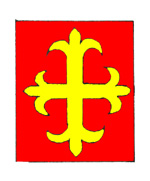The Lesser Cardington Manor

Barony of Bedford
Volume Three of The Victoria County History for Bedfordshire, published in 1912 gives a summary history of each of the manors in Cardington. The main manor can be traced back to the holding recorded in Domesday Book of 1086 as belonging to Hugh de Beauchamp, created Baron of Bedford by King William II (1087-1100). The manor remained in the Beauchamp family until 1265 when John de Beauchamp was killed at the Battle of Evesham fighting for Simon de Montfort against King Henry III (1216-1272). The manor, like the rest of John’s substantial possessions, including the Barony of Bedford, was then divided.
A lesser part of the manor passed to Beatrice, youngest sister of John de Beauchamp and was, confusingly, simply known, like the greater part of the original manor, as Cardington Manor; the other lesser portion was later known as Wake Manor. Beatrice was wife of Thomas Fitz Otho, who died in 1274 and she then married William de Monchessy.

The coat of arms of Lord Latimer
The property passed to Beatrice’s daughter by Thomas, Maud, who became wife of John de Botetourt. Their daughter Elizabeth married William de Latimer and the manor thus passed into that family. William Latimer’s granddaughter married John de Nevill of Raby in Leicestershire and the manor remained in this family until 1577 and the death of Sir John Nevill, Lord Latimer. The manor then passed to his second daughter Dorothy, wife of Thomas Cecil, 1st Earl of Exeter (half brother of Elizabeth I’s Lord High Treasurer Robert Cecil, 1st Earl of Salisbury). The last mention of the manor in the historical record is in 1643 when the 3rd Earl of Exeter died. Exeter Wood, presumably part of the manor, was purchased by Samuel Charles Whitbread in 1879 from the 2nd Marquess of Exeter.